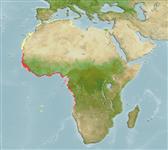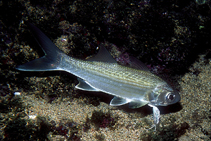Galeoides decadactylus (Bloch, 1795)
Lesser African threadfin
Ajouter votre observation dans Fish Watcher
| Native range | All suitable habitat | Point map | Year 2050 |

|
| This map was computer-generated and has not yet been reviewed. |
| Galeoides decadactylus AquaMaps Data sources: GBIF OBIS |
Envoyez vos Photos et vidéos
Pictures | Stamps, coins, misc. | Images GoogleGaleoides decadactylus
Picture by Wirtz, P.
Pictures | Stamps, coins, misc. | Images GoogleGaleoides decadactylus
Picture by Wirtz, P.
Ivory Coast (Côte d'Ivoire) country information
Common names:
Abogne, Ébo, Obo
Occurrence: native
Salinity: brackish
Abundance: | Ref:
Importance: | Ref:
Aquaculture: | Ref:
Regulations: | Ref:
Uses: no uses
Comments: Occurs in Ébrié Lagoon (Ref. 28587).
National Checklist:
Country Information: https://www.cia.gov/library/publications/resources/the-world-factbook/geos/iv.html
National Fisheries Authority:
Occurrences: Occurrences Point map
Main Ref: Diouf, P.S., 1996
National Database:
Occurrence: native
Salinity: brackish
Abundance: | Ref:
Importance: | Ref:
Aquaculture: | Ref:
Regulations: | Ref:
Uses: no uses
Comments: Occurs in Ébrié Lagoon (Ref. 28587).
National Checklist:
Country Information: https://www.cia.gov/library/publications/resources/the-world-factbook/geos/iv.html
National Fisheries Authority:
Occurrences: Occurrences Point map
Main Ref: Diouf, P.S., 1996
National Database:
Common names from other countries
Classification / Names Noms communs | Synonymes | Catalog of Fishes(Genre, Espèce) | ITIS | CoL | WoRMS | Cloffa
> Carangaria/misc (Various families in series Carangaria) > Polynemidae (Threadfins)
Etymology: Galeoides: Greek, galeos = a shark + suffix oides = similar to (Ref. 45335).
More on author: Bloch.
Etymology: Galeoides: Greek, galeos = a shark + suffix oides = similar to (Ref. 45335).
More on author: Bloch.
Environment: milieu / climate zone / depth range / distribution range Écologie
marin; saumâtre démersal; profondeur 10 - 70 m (Ref. 10799). Subtropical; 37°N - 27°S, 19°W - 16°E (Ref. 57343)
Distribution Pays | Zones FAO | Écosystèmes | Occurrences | Point map | Introductions | Faunafri
Eastern Atlantic: West African coasts, from Canary Islands and Morocco to Angola (Ref. 57402). Sporadically known from Algeria and Namibia (Ref. 57343). Record from Mauritius is likely to be erroneous.
Length at first maturity / Taille / Poids / Âge
Maturity: Lm 11.6 range ? - ? cm
Max length : 50.0 cm TL mâle / non sexé; (Ref. 5377); common length : 30.0 cm TL mâle / non sexé; (Ref. 3659)
Max length : 50.0 cm TL mâle / non sexé; (Ref. 5377); common length : 30.0 cm TL mâle / non sexé; (Ref. 3659)
Description synthétique Clés d'identification | Morphologie | Morphométrie
Épines dorsales (Total) : 9; Rayons mous dorsaux (Total) : 13 - 14. Diagnosis: 9-10 short detached pectoral filaments, not exceeding length of upper pectoral fin; body moderately elongate and compressed, its height comprised 2.9-3.4 times in standard length; snout very short, blunt and prominent; mouth inferior; posterior edge of maxillary only slightly expanded, barely reaching past eye; 2 widely separated dorsal fins, 1st with 8 spines, 2nd with 1 flexible spine and 13-14 soft rays; 2nd
dorsal fin and anal fin bases barely equal; pectoral fin inserted low on body; scales ctenoid; head and unpaired fins partly covered with small scales (Ref. 57402).
Coloration: body uniformly silvery, upper part greyish and belly white; a large rounded black spot, about equal to eye diameter, generally visible under lateral line, behind opercle (Ref. 57402).
Occurs over sandy (Ref. 2683) and muddy bottoms in shallow waters (Ref. 4340), frequently in brackish habitats (Ref. 4340, 57402) and estuaries, but not in freshwaters (Ref. 57402). Feeds on benthic invertebrates (Ref. 5377). Sold fresh, dried salted or smoked (Ref. 36127).
Life cycle and mating behavior Maturité | Reproduction | Frai | Œufs | Fécondité | Larves
Also Ref. 32209.
Référence principale
Upload your references | Références | Coordinateur | Collaborateurs
Daget, J. and J.C. Njock, 1986. Polynemidae. p. 352-354. In J. Daget, J.-P. Gosse and D.F.E. Thys van den Audenaerde (eds.) Check-list of the freshwater fishes of Africa (CLOFFA). ISNB, Brussels; MRAC, Tervuren; and ORSTOM, Paris. Vol. 2. (Ref. 4340)
Statut dans la liste rouge de l'IUCN (Ref. 130435: Version 2024-2)
Quasi-menacé (NT) ; Date assessed: 15 July 2014
Menace pour l'homme
Harmless
Utilisations par l'homme
Pêcheries: commercial
FAO(pêcheries: production, Résumé espèce; publication : search) | FIRMS (Stock assessments) | FishSource | Sea Around Us
Plus d'informations
Trophic ecology
Éléments du régime alimentaire
Composition du régime alimentaire
Consommation alimentaire
Food rations
Prédateurs
Éléments du régime alimentaire
Composition du régime alimentaire
Consommation alimentaire
Food rations
Prédateurs
Population dynamics
Paramètres de croissance
Max. ages / sizes
Length-weight rel.
Length-length rel.
Fréquences de longueurs
Mass conversion
Recrutement
Abondance
Paramètres de croissance
Max. ages / sizes
Length-weight rel.
Length-length rel.
Fréquences de longueurs
Mass conversion
Recrutement
Abondance
Life cycle
Reproduction
Maturité
Fécondité
Frai
Spawning aggregations
Œufs
Développement de l'œuf
Larves
Dynamique des populations larvaires
Reproduction
Maturité
Fécondité
Frai
Spawning aggregations
Œufs
Développement de l'œuf
Larves
Dynamique des populations larvaires
Anatomy
Surface branchiale
Brain
Otolith
Surface branchiale
Brain
Otolith
Physiology
Body composition
Nutrients
Consommation d'oxygène
Type de nage
Vitesse de nage
Visual pigments
Fish sound
Diseases & Parasites
Toxicity (LC50s)
Body composition
Nutrients
Consommation d'oxygène
Type de nage
Vitesse de nage
Visual pigments
Fish sound
Diseases & Parasites
Toxicity (LC50s)
Genetics
Génétique
Heterozygosity
Héritabilité
Génétique
Heterozygosity
Héritabilité
Human related
Aquaculture systems
Profils d'aquaculture
Souches
Ciguatera cases
Stamps, coins, misc.
Aquaculture systems
Profils d'aquaculture
Souches
Ciguatera cases
Stamps, coins, misc.
Outils
E-book | Guide de terrain | Clés d'identification | Générateur de fréquences de longueur | Outil de dynamique de population | Carte par point | Classification Tree
| Catch-MSY |
Articles particuliers
Télécharger en XML
Sources Internet
Aquatic Commons | BHL | Cloffa | Websites from users | FishWatcher | CISTI | Catalog of Fishes(Genre, Espèce) | DiscoverLife | ECOTOX | Faunafri | Fishtrace | GenBank(génôme, nucléotide) | GloBI | GOBASE | | Google Books | Google Scholar | Google | IGFA World Record | MitoFish | Bases de données nationales | Otolith Atlas of Taiwan Fishes | PubMed | Reef Life Survey | Scirus | SeaLifeBase | Arbre de Vie | Wikipedia(aller à, chercher) | World Records Freshwater Fishing | Zoological Record
Estimates based on models
Preferred temperature (Ref. 115969): 20.1 - 27.9, mean 25.9 (based on 66 cells).
Phylogenetic diversity index (Ref. 82804): PD50 = 1.0000 [Uniqueness, from 0.5 = low to 2.0 = high].
Bayesian length-weight: a=0.00851 (0.00542 - 0.01337), b=3.11 (2.98 - 3.24), in cm Total Length, based on LWR estimates for this species & (Sub)family-body (Ref. 93245).
Niveau trophique (Ref. 69278): 3.6 ±0.67 se; based on food items.
Résilience (Ref. 120179): Milieu, temps minimum de doublement de population : 1,4 à 4,4 années (K=0.14-0.4).
Prior r = 0.49, 95% CL = 0.32 - 0.73, Based on 2 data-limited stock assessments.
Fishing Vulnerability (Ref. 59153): Low to moderate vulnerability (30 of 100).
Climate Vulnerability (Ref. 125649): Very high vulnerability (77 of 100).




